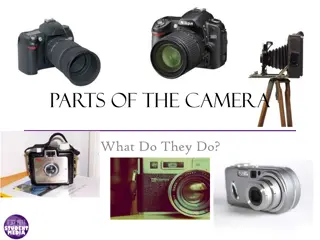Photography Basics: Understanding Camera Exposure and Metering
Explore the fundamentals of camera exposure, including aperture, shutter speed, ISO, and metering modes. Learn how to control exposure settings, utilize different metering modes, and troubleshoot common exposure issues to enhance your photography skills.
Download Presentation

Please find below an Image/Link to download the presentation.
The content on the website is provided AS IS for your information and personal use only. It may not be sold, licensed, or shared on other websites without obtaining consent from the author. Download presentation by click this link. If you encounter any issues during the download, it is possible that the publisher has removed the file from their server.
E N D
Presentation Transcript
Photo 101 Session 2 Karen Smale April 2015
Review of Session 1 Elements of a camera Types of cameras Did you find/read your manual? Do you have multiple focusing modes and/or manual controls? Exposure Aperture Shutter speed ISO
Exposure Review Combo of aperture, shutter speed & ISO f/29, 1/2s, ISO 500 f/8, 1/8s, ISO 500 f/4.5, 1/20s, ISO 500 f/8, 1/20s, ISO 1600
Session 2 Metering modes How does your camera know how to make the proper exposure and how can you help it to make the right decision Exposure Compensation How to override what your camera thinks is proper White Balance How to fix the color on those indoor photos Gadgets
In-camera Exposure Metering Almost all cameras have a built-in meter that will adjust ISO, Aperture and Shutter Speed automatically to yield a proper exposure. Some cameras allow you to control how the camera determines proper exposure. Sometimes the camera s idea of proper exposure does not match yours.
Metering: How does it work? Camera uses Through-The-Lens (TTL) meter to evaluate the light in the scene Camera wants the scene to be mostly mid- tones Histogram
Metering Modes Multi-zone (evaluative, matrix) Evaluates whole scene (60% center, 40% other) Great for evenly lit scenes, fine most of time Center-weight (partial) Gives preference to exposure of central (~10%) area Great for scenes with well-lit center, unimportant dark areas around edges, e.g., portraits Spot Gives preference to small (~2-3%) area Gives precise control over exposure of one important area If the metering spot you want to use isn t in the center of your frame, use AEL (Exposure Lock) button press to hold the exposure while you recompose
Pop Quiz!! What metering mode? Choose: Multi-zone/ Matrix/ Evaluative Center- Weighted Spot
Sometimes it doesnt work Remember: Camera wants the scene to be mostly mid-tones Dark image Bright image Camera will adjust to compensate for overly- bright or overly-dark scenes
Exposure compensation Overrides your automatic metering Increase/decrease exposure, usually in 0.3-stop increments No exposure compensation No exposure compensation would make this look like daytime -1EV gives the dark mood we want (photo by Joel Gambino) +2EV exposure compensation
Limits of Exposure Dynamic Range refers to the extremes of light and dark that a camera can render. Clipping or Blown refer to pixels that are overexposed beyond the limit of the sensor Shadows refer to pixels that are underexposed beyond the limit of the sensor Camera review can be set to show shadows or highlight. And check your histogram!
Color balance / white balance (WB) Color Temperature Adjust for incandescent and fluorescent lighting The camera has several presets including Auto, Daylight, Cloudy, Tungsten. Beware mixed light sources with different color temperatures (i.e.: shooting indoors with fluorescent lighting next to a window to daylight)
White balance correction Camera set to fluorescent Uncorrected
Gadgets Spare batteries Spare memory cards Camera Bag Tripod/Monopod Lens cleaner Lens caps UV filter Lens hood Polarizer / ND filter Shutter release Remote control External flash Reflectors/ diffusers Color checker Drone
Homework Find your manual and check out your Metering modes Exposure compensation White balance and how to change them! Photograph a scene using different metering modes Try it again with one metering mode but different exposure compensations Try different WB settings























